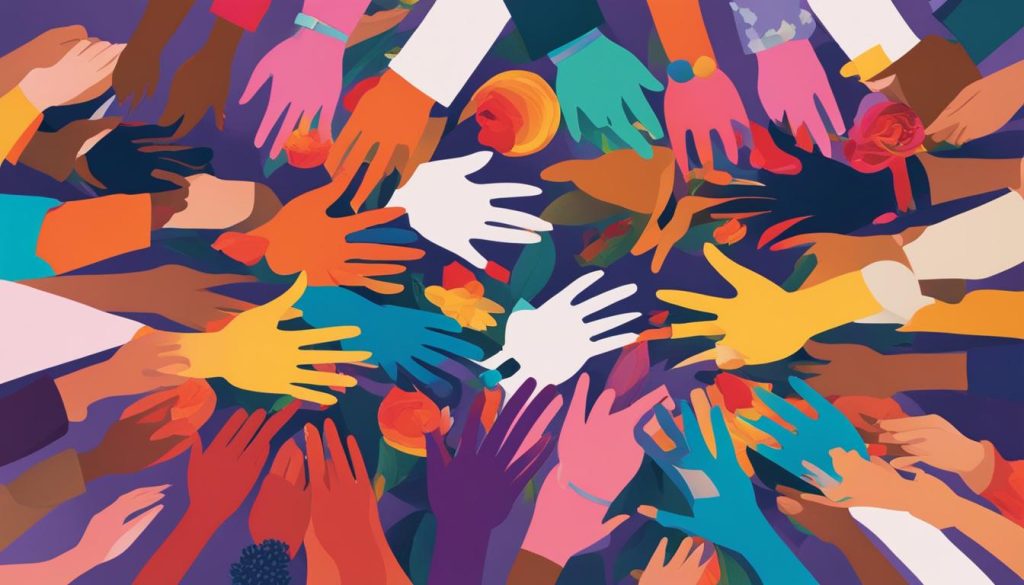Colors have a powerful impact on our emotions and play a significant role in shaping our experiences. This is especially true in interior design, where the choice of colors can create a harmonious and inviting atmosphere. But did you know that colors also have the power to influence our relationships and social connections?
When we talk about a social wellness palette, we’re referring to the strategic use of colors to create spaces that promote diverse relationships, nourish connections, and embrace diversity. Designers can build social networks and foster a sense of belonging and inclusivity by carefully selecting colors that resonate with different cultures, values, and preferences.
Imagine walking into a space that is filled with vibrant hues and inviting tones. The colors surrounding you evoke feelings of warmth, positivity, and acceptance. These colors create an environment that encourages interaction, sparks conversations, and fosters meaningful connections.
But how exactly do colors impact our social well-being? Different cultures have unique color associations and symbolism deeply rooted in their traditions and beliefs. Understanding these cultural connotations is essential when selecting color palettes to ensure they resonate positively with the intended audience.
In addition to cultural trends, social trends also play a significant role in color palette selection. Trends such as sustainability, minimalism, wellness, and inclusivity influence the choice of colors, creating spaces that align with the values and preferences of the target audience.
Key Takeaways:
- A social wellness palette uses colors strategically to promote and embrace diverse relationships.
- Colors have the power to evoke emotions and create environments that encourage social interaction.
- Understanding cultural associations and social trends is crucial when selecting color palettes.
- Colors influenced by sustainability, minimalism, wellness, and inclusivity create spaces that resonate with the target audience.
- A well-designed social wellness palette can build social networks and foster a sense of belonging and inclusivity.
The Influence of Cultural Trends on Color Palette Selection
Colors hold a significant cultural significance and symbolism, influencing our perceptions, emotions, and experiences. When it comes to interior design, understanding the influence of cultural trends on color palette selection is crucial. Different cultures have unique color associations and symbolism deeply rooted in their traditions, beliefs, and historical contexts. For instance, the color red symbolizes luck and prosperity in Chinese culture, while in Western cultures, it represents love and passion.
By incorporating these cultural connotations into color palettes, designers can create spaces that resonate positively with the intended audience. Other colors like white, yellow, blue, and green also have different cultural associations and meanings in various cultures. For example, white can symbolize purity and innocence in Western cultures, while in many Eastern cultures, it represents mourning and death. Understanding these cultural nuances allows designers to select color palettes that align with the values and preferences of the target audience.
The Role of Symbolism in Social Wellness Palette
Symbolism plays a significant role in color palette selection. Colors can evoke specific emotions and convey messages without the need for words. By utilizing colors with cultural connotations, designers can create spaces that evoke the desired atmosphere and communicate specific meanings. For instance, using warm earthy tones like brown and terracotta can create a sense of grounding and connection to nature, while vibrant and bold colors like orange and yellow can evoke energy and positivity.
“Colors are a universal language that can express emotions, tell stories, and create connections between people from different cultures.”
Designers can leverage symbolism to create meaningful and culturally inclusive spaces. By carefully selecting colors that align with the cultural trends and preferences of the intended audience, designers can foster a sense of belonging and create spaces that resonate with individuals on a deeper level.
| Cultural Association | Color | Symbolism |
|---|---|---|
| Chinese | Red | Luck and prosperity |
| Western | Red | Love and passion |
| Western | White | Purity and innocence |
| Eastern | White | Mourning and death |
Understanding the influence of cultural trends and symbolism on color palette selection allows designers to create spaces that reflect the desired aesthetic and resonate with the audience’s cultural background and values. Designers can transform spaces into meaningful and visually engaging environments by leveraging the power of colors and their cultural connotations.
The Impact of Social Trends on Color Palette Selection
Social trends profoundly influence the selection of color palettes in interior design. As society evolves and new trends emerge, designers adapt their color choices to create spaces that resonate with the values and preferences of their target audience. Several social trends, such as sustainability, minimalism, wellness, and inclusivity, have significantly shaped color palette selection in recent years.
One prominent social trend that has influenced color choices is sustainability. With an increasing focus on eco-consciousness, designers are opting for natural and earthy tones in their color palettes. These colors align with the principles of sustainability and create a sense of harmony and connection with the natural environment.
Another influential trend is minimalism, which emphasizes simplicity and functionality. In color palette selection, minimalism often translates to neutral colors such as whites, grays, and beiges. These colors create a clean and uncluttered aesthetic, allowing the focus to be on the functionality of the space.
“Colors are like a language, and they can communicate different emotions and messages. By understanding social trends and their impact on color palette selection, designers can create spaces that truly resonate with people.”
Wellness is also a significant social trend that has influenced color choices. Certain colors, such as calming blues and soothing greens, are associated with relaxation and promoting a sense of well-being. These colors are often used in spaces where people seek to unwind and rejuvenate, such as bedrooms, spas, and meditation rooms.
Inclusivity is another essential aspect of social trends in color palette selection. Designers are increasingly embracing diversity by incorporating a wide range of colors that reflect different cultures and backgrounds. This inclusivity allows spaces to be more representative of our diverse communities, fostering a sense of belonging and acceptance.
The Impact of Social Trends on Color Palette Selection
The impact of social trends on color palette selection is evident in interior design. From sustainability and minimalism to wellness and inclusivity, these trends shape the choices designers make to create spaces that align with the values and preferences of their target audience. By understanding and incorporating these social trends into their design process, designers can create aesthetically pleasing and emotionally engaging environments that truly resonate with people.
| Social Trend | Color Palette Influence |
|---|---|
| Sustainability | Natural and earthy tones |
| Minimalism | Neutral colors: whites, grays, beiges |
| Wellness | Calming blues and soothing greens |
| Inclusivity | Diverse range of colors reflecting different cultures and backgrounds |
By incorporating these color trends influenced by social factors, designers can create spaces that reflect the current cultural context and contribute to the overall well-being and satisfaction of those who inhabit those spaces.

Trend Forecasting and Consideration of the Target Audience
Trend forecasting and understanding the target audience’s preferences are essential aspects of color palette selection in interior design. By staying updated on emerging color trends and considering the demographic factors that shape design preferences, designers can create harmonious and meaningful environments that resonate with their audience.
Trend Forecasting for Color Palette Selection
In order to create spaces that feel current and reflect the zeitgeist, designers rely on trend forecasting. Designers can predict emerging color trends by analyzing fashion shows, global events, consumer behavior, and design exhibitions. This allows them to incorporate relevant colors into their projects and stay ahead of the curve.
For example, if trend forecasting indicates that earthy tones and organic colors will be popular in the coming year, designers can incorporate these colors into their color palettes. This ensures that their designs feel fresh and aligned with the current design trends, ultimately creating spaces that resonate with the target audience.
Consideration of the Target Audience’s Preferences
Understanding the preferences of the target audience is paramount in color palette selection. Demographic factors such as age, gender, cultural background, and geographic location significantly influence design preferences. By considering these factors, designers can tailor their color palettes to create environments that resonate with the target audience.
For example, if the target audience is a young, culturally diverse demographic, designers may opt for vibrant and bold colors to create energetic and uplifting spaces. On the other hand, if the target audience is a more mature demographic, designers may choose more muted and sophisticated colors to create a sense of elegance and refinement.
| Demographic Factor | Design Preference |
|---|---|
| Age | Youthful demographic may prefer vibrant colors, while a more mature demographic may prefer muted tones. |
| Gender | Gender preferences may influence color choices, such as stereotypical associations of pink with femininity and blue with masculinity. |
| Cultural Background | Cultural associations and symbolism may influence color preferences. |
| Geographic Location | Regional preferences and climate may influence color choices. |
By considering the target audience’s preferences and incorporating trend forecasting, designers can create color palettes that not only align with current design trends but also resonate with the emotions and aspirations of the intended audience. This thoughtful approach to color palette selection ensures that the designed spaces are visually appealing and create a sense of connection and comfort for the people who inhabit them.

Summary
Trend forecasting and consideration of the target audience’s preferences are vital elements in color palette selection for interior design. By staying updated on emerging color trends and understanding the demographic factors that shape design preferences, designers can create spaces that feel current and resonate with the intended audience. This thoughtful approach ensures that the color palettes align with the current design trends and create harmonious and meaningful environments that promote social well-being and enhance the overall quality of life.
Conclusion
The influence of cultural and social trends on color palette selection in interior design is undeniable. By understanding these trends and their impact, I can create aesthetically pleasing spaces that resonate with your emotions and aspirations. Incorporating elements of color psychology and considering your preferences, I can craft healthy and vibrant environments that promote social well-being and enhance your overall quality of life.
Color design plays a crucial role in your physical and mental well-being in a community health environment. By utilizing the principles of color psychology and trend forecasting, I can create spaces that nourish your relationships and embrace diversity and build thriving social networks, transforming the world we live in.
Together, we can bring harmony and balance to your space, ensuring that it promotes your health and well-being. Let’s embark on this journey together and create a space that reflects who you are, nurtures your relationships, and inspires you to live your best life.
FAQ
What role do cultural trends play in color palette selection in interior design?
Cultural trends have a profound influence on color choices in interior design. Different cultures have unique color associations and symbolism deeply rooted in their traditions, beliefs, and historical contexts.
How do social trends impact color palette selection in interior design?
Social trends influenced by fashion, technology, art, and lifestyle shape the choice of colors in interior design. Trends like sustainability, minimalism, wellness, inclusivity, and cultural diversity influence color palette selection.
How do designers stay updated on color trends?
Designers analyze factors such as fashion shows, global events, consumer behavior, and design exhibitions to predict emerging color trends. By staying updated on these forecasts, designers can incorporate relevant colors into their projects.
Why is consideration of the target audience important in color palette selection?
Understanding the preferences and expectations of the target audience helps designers tailor their color palettes and create harmonious and meaningful environments.
How do colors influence community health environments?
The color choices in a community health environment contribute to the physical and mental well-being of its residents, making it an essential aspect of design to prioritize. By utilizing the principles of color psychology and trend forecasting, designers can create spaces that promote social well-being and enhance the overall quality of life.

